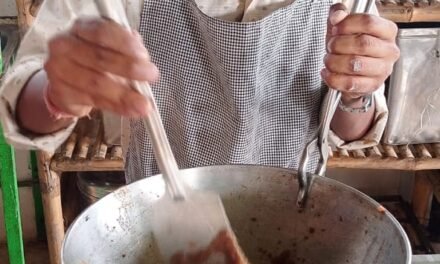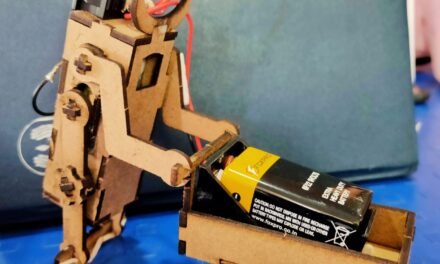What is Grey Water?
Greywater is specifically waste water which contains used water like washing machine, kitchen, bathroom, basin waste and free from human excreta (called as black water). It can be used for Agriculture use, home garden also in toilet flush after proper treatment also beneficial for developers, builders and contractors on their sites.
As per the research estimates, each person consumes approximately 100-120 litres per day- equating the domestic use like shower, washing of cloths, Brushing teeth, flushing, preparing food, washing dishes.
Objective of the Project
To Design Compact Grey Water system for a Household

This system mainly consists of grey water tank we can called it as settler tank, Reed bed system and storage tank other than that there is filter, water pump, Air pump as bubbler and timer Unit to control water pump and air bubbler.
Settler Tank
Sedimentation tank, also called settling tank or clarifier, component of a modern system of water supply or wastewater treatment. A sedimentation tank allows suspended particles to settle out of water or wastewater as it flows slowly through the tank, thereby providing some degree of purification.
Reed bed system
Reed beds are natural habitats found in floodplains, waterlogged depressions, and estuaries. Reed beds are part of a succession from young reeds colonising open water or wet ground through a gradation of increasingly dry ground. As reed beds age, they build up a considerable litter layer that eventually rises above the water level and that ultimately provides opportunities for scrub or woodland invasion. Artificial reed beds are used to remove pollutants from grey water.
There are three types of reed bed system
1. Vertical reed bed system
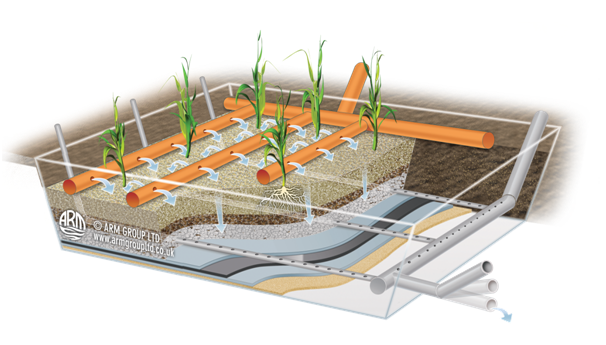
A vertical flow reed-bed is a reed-bed in which the effluent is periodically dosed uniformly over the surface of the bed by means of a network of pipes. The effluent percolates vertically down through the media and is collected by drainage pipes at the bottom which discharge to the next reed-bed in a series or directly into a watercourse or pond. The bed then remains empty of water until the next dose is applied.
Vertical Flow Reed-beds are designed to be aerobic and to nitrify ammonia converting it into nitrates and nitrites.
2. Horizontal reed bed system
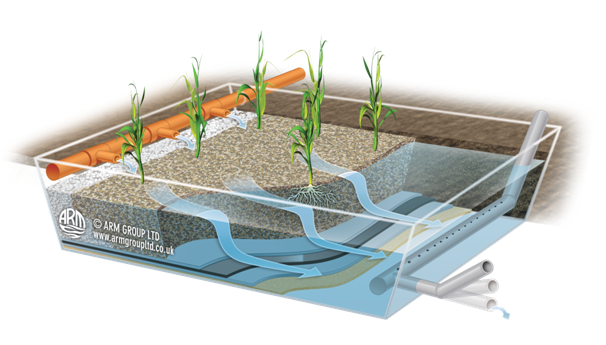
Horizontal flow reed-bed is one in which effluent is applied at one end and discharges from the other. The bed remains full of water at all times. In the Sub-Surface Flow type the level of the water is carefully controlled so that it is always 25-50 mm below the surface of the gravel media.
Horizontal flow reed-beds are generally low in oxygen and will de-nitrify the effluent converting the nitrogenous compounds into free nitrogen gas which escapes to the atmosphere.
3. Down flow reed bed system
Multi-stage reed-bed systems, incorporating two stages of vertical flow. They work on a ‘fill and drain’ system, where one bed fills over 12 hours whilst the other one drains and vice versa. The idea is that as the effluent drains out of the gravel, air is pulled in and helps to form an aerobic bacterial colony on the gravel surface to digest the pollutants.
These systems invariably require the use of electric pumps, timers and control panels as the effluent is switched from one bed to the other every 12 hours.
Down-flow reed-beds are normally used for treating septic tank effluent.
This beds are designed to have minimum retention time of 2-5 days to reduce the COD of the water as per to the standards.
Siphon Principle
A siphon is any of a wide variety of devices that involve the flow of liquids through tubes. In a narrower sense, the word refers particularly to a tube in an inverted “U” shape, which causes a liquid to flow upward, above the surface of a reservoir, with no pump, but powered by the fall of the liquid as it flows down the tube under the pull of gravity, then discharging at a level lower than the surface of the reservoir from which it came.
Use of siphon in this system reduced the use of motor to pump water from the reed beds to storage tank
Design Consideration
According to the Vigyan Ashram’s Requirement the design should be easy to manufacture and the components or materials are standard which can easily available in the market.
For settler tank I have considered 100 liter Crate

For Reed beds 250 liter Crate

For storage tank 250 liter Barrel Drum

For filtering the water of storage tank to main tank where the recycled water which is used again the Y shaped Disc filter is used.
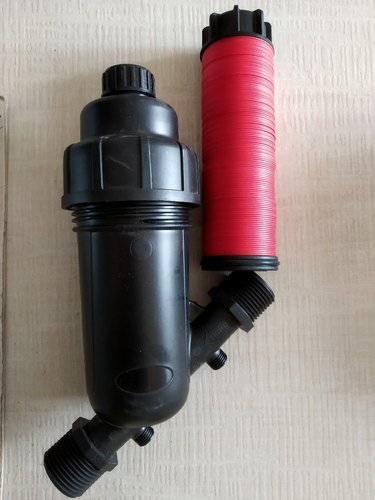
For aeration in the storage tank Air Bubbler is used.

For pumping of water from the storage tank to red beds and to the main tank pump is used.
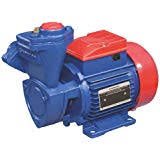
These all materials are easily available in the market and as per the client requirement they can update the system to 500 Litre to 750 Litre by simply adding the Crate and Barrel drum.
This product is specially designed for a family of five people which can be expanded by adding of Reed bed Crates and storage tank according to their requirement.
References
https://www.reedbeds.co.uk/page/what-is-a-vertical-flow-reed-bed.php


